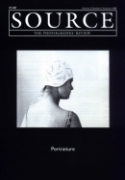World Press Photo
Book Review by Mary Fitzpatrick
Issue 9 Autumn 1996
View Contents ▸
Published by: Thames & Hudson Ltd.
ISBN: 0500974365
Price: £9.95
"The advantage photography has over any other art form is it's ability to freeze a moment in time, allowing the viewer to see things that would otherwise remain hidden. Documentary photography presents history, culture and the world around us in a deeper way than any other medium. That can be very revealing, and I believe it is the characteristic that will ensure the future of photojournalism."
Lucian Perkins, the winner of the 1996 World Press Photo of the year award sums up his attitude towards photography as an artform, he goes on to say that he does not distinguish between "documentary" and "fine art" photography, in his view "they have been merging in recent years". His 'Photo of the Year' is unusual but very beautiful. It is not the dramatic 'big picture' which we may have expected but is, rather, a quiet and reflective image. It shows a small Chechen boy, his palms pressed hard against the back window of a bus through which he is gazes, his face contorted with intense and almost tangible anxiety. A fleeting moment of contact between the boy and the photographer. "It was a face that symbolised the all that he had seen". Symbolised all that Perkins had seen? Perhaps the boys face encapsulated all that the child himself had seen in the Chechen war. Lucian Perkins, World Press Photo of the Year 1996
Lucian Perkins, World Press Photo of the Year 1996
The book is full of prize winning black and white photo-essay entries many of them capturing the absolute horrors of war and following that very particular photographic genre of 'humanist' documentary. It is frustrating that this type of photography is given such ephemeral status and is often allocated the same life expectancy as the newspapers in which they appear. These photographs should be remembered next year and not discarded as old news, they are, I believe, worth more than that.
Chechnya, Bosnia and Rwanda dominate the war stories. It is difficult to know how the selection is made, is it the importance of the event, or the quality of the photography? The number of images detailing the dead and dying makes it is difficult to talk about the aesthetics of such representations. Amongst those I found most striking are Eric Bouvet's portrait of a captured Chechan rebel, Nadia Benchallal's photographs from Bosnia showing the hardships faced by the Muslim women displaced from their homes in the former Yugoslavia and Paul Lowe's work from Rwanda which gives us a very harrowing, apocalyptic view of the cruelties human beings can inflict on one another.
All is not doom and gloom though as other sections of the book reveal more positive visual stimulation. Olivier Blaise's swimming elephant in the 'Nature and the Environment' section, Zeng Nian's view of the Chinese Acrobatic Troupe for disabled children in 'The Arts' and Barbara Kinney's 'People In The News' photograph taken behind the scenes at the Whitehouse during Arab Israeli negotiations. Barbara Kinney, People in the News, First Prize 1996
Barbara Kinney, People in the News, First Prize 1996
An image of survival is produced by Joe McNally, it shows Kim Phuc now grown up, holding her baby son in her arms. She featured in the Press Photo of 1972 when her village was hit by US napalm. That famous photograph by Nick Ut shows Kim Phuc running naked down a road burning. It has been said that the image was so shocking for it's time that it hastened the end of the Vietnam war. It stands out amongst the most remembered images of the twentieth century. This in turn makes the contemporary photograph disconcerting in relation to such an iconic image.
These are very powerful images and it seems that to produce this kind of work you need the obligatory wide-angle lens, loads of black and white film and a strong constitution. It would help if you also acquired a penis somewhere along the way. There doesn't seem to be much room for us gals in this macho world.
At £9.95 this book is excellent value for those who enjoy documentary photography. The printing quality is good and with over 100 pages the viewer can get a fairly substantial insight into some of the best press work of the year. However, when one considers the amount of entries to the contest it is only an insight.
Other articles on photography from the 'Photojournalism' category ▸





